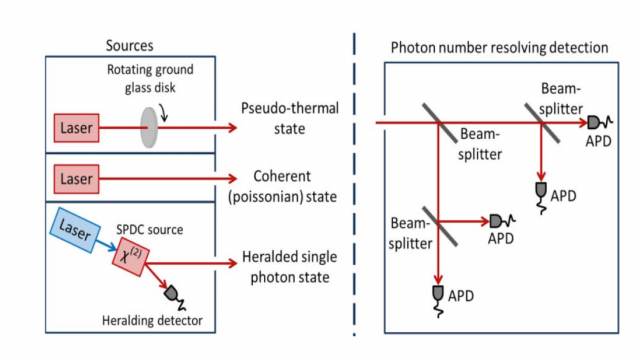Aug 17 2013
The photodetectors in Alan Migdall’s lab often see no light at all, and that’s a good thing since he and his JQI (*) colleagues perform physics experiments that require very little light, the better to study subtle quantum effects.

The bursts of light they observe typically consist of only one or two photons--- the particle form of light---or (statistically speaking) even less than one photon. Their latest achievement is to develop a new way of counting photons to understand the sources and modes of light in modern physics experiments.
Migdall’s lab, located at the National Institute for Standards and Technology (NIST), is just outside Washington, DC in the US. The new light-measuring protocol is summarized in a recent issue of the journal Physical Review A (see reference publication). The work reported there was performed in collaboration with NIST’s Italian counterpart, the Instituto Nazionale de Ricerca Metrologica (INRIM).
Light Modes
Generating light suitable for quantum mechanical applications such as quantum computing and quantum cryptography requires exquisite control over properties such as the frequency, polarization, timing, and direction of the light emitted. For instance, probing atoms with light involves matching the frequency of the light to the atoms’ natural resonance frequency often to within one part in a billion. Moreover, communicating with light means encoding information in the arrival time or frequency or spatial position of the light, so high-speed communication means using very closely- spaced arrival times for light pulses, and pinpoint knowledge of the light frequencies and positions of the arriving light in order to fit in as much information as possible.
When a light pulse contains a mixture of light photons with different frequencies (or polarizations, arrival times, emission angles, etc.) it is said to have multiple modes. In some cases, a single light source will naturally produce such multi-mode light, whereas in others multiple modes are a signature of the presence of additional, and generally unwanted, light sources in the system. Discriminating the different modes in a light field, especially a weak light field that has very few photons, can be extremely difficult as it requires very sensitive detection that can discriminate between modes that are very close together in frequency, space, time, etc.
For instance, to study a pair of entangled photons (created by shooting light into a special crystal where one photon is converted into a pair of secondary, related photons) detection efficiency is all important; and folded into that detection efficiency is a requirement that the arrival of each of the daughter photons be matched to the arrival of the other daughter photon. In addition to this temporal alignment, the spatial alignment of detectors, (each oriented at a specific angle respect to the beamline) must be exquisite. To correct for any type of less-than-perfect alignment, it is necessary to know how many different light modes are arriving at the detector.
Photon Number
The laws of quantum mechanics ensure that light always exhibits natural intensity fluctuations. Even from an ultra-stable laser, the number of photons arriving at a detector will vary randomly in time. By recording the number of photons in each pulse of light over a long time, however, the form of the fluctuations of a particular light field will become clear. In particular, we can learn the probability of generating 0, 1, 2, 3, etc. photons in each pulse.
The handy innovation in Migdall’s lab was to develop a method to use this set of probabilities to determine the modes in a very weak light field. This method is very useful because most light detectors that can see light at the level of a single photon cannot tell the exact frequency or position of the light, which makes determining the number of modes difficult for such fields.
The JQI-INRIM experiment used a detector “tree” that counts photon number. It did this by taking the incoming light pulse, using partial mirrors to divide the pulse into four, and then allowing these to enter four detectors set up to record individual photons. If the original pulse contained zero photons then none of the detectors will fire. If the pulse contained one photon, then one of the detectors will fire, and so on.
Elizabeth A. Goldschmidt, a JQI researcher and University of Maryland graduate student, is the first author on the research paper. “By looking at just the intensity fluctuations of a light field we have shown that we can learn about the underlying processes generating the light,” she said. “This is a novel use of higher-order photon-number statistics, which are becoming more and more accessible with modern photodetection.”
Goldschmidt believes that this method of counting photons and statistically analyzing the results as a way of understanding the modes present in light pulses will help in keeping tight control over light sources that emit single photons (where, for instance, you want to ensure that unwanted photons are not being produced). And those that emit pairs of entangled photons---where the quantum relation between the two photons is exactly right, such as in “heralding” experiments, where the detection of a photon in one detector serves as an announcement for the existence of a second, related, photon in a specially staged detector nearby (see related articles).
Alan Migdall compares the photon counting approach to wine tasting. “Just as some experts can taste different flavors in a wine---a result of grapes coming from different parts of the Loire Valley---so we can tell apart various modes of light coming from a source.”
(*)The Joint Quantum Institute is operated jointly by the National Institute of Standards and Technology in Gaithersburg, MD and the University of Maryland in College Park.